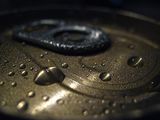condensation
Condensation is the process where water vapor becomes liquid
Water Condenses on an Aluminium Can
For upon |Water condenses on a can of cold soda. Water vapor in the air reaches its dew point as it cools in the air around them can, forming liquid drops of water.
Dewdrops on a Dahlia
Morning condensation, or dew, stays on this dahlia until the sun evaporates it. Water condenses or turns from vapor to liquid when it reaches its dew point. Calculating the dew point is a complex set of formulas, called a psychometric chart, involving humidity, air pressure, and temperature.
Cassiar Mountain Storm, Canada
Clouds sweep across the Cassiar Mountains in British Columbia, Canada. As water vapor collects in clouds, they become saturated. When clouds are saturated with water vapor, the density, or closeness, of the molecules increases. The vapor condenses and becomes rain.
Bat-sickle
This small bat, near the entrance of Indian Grave Point Cave, Tennessee, was covered in condensation (liquid water) as the air around it reached the dew point. As the temperature sank lower, the condensation turned to ice.
Condensation is the process where water vapor becomes liquid. It is the reverse of evaporation, where liquid water becomes a vapor.
Condensation happens one of two ways: Either the air is cooled to its dew point or it becomes so saturated with water vapor that it cannot hold any more water.
Dew Point
Dew point is the temperature at which condensation happens. (Dew is simply condensed water in the atmosphere.) Air temperatures can reach or fall below the dew point naturally, as they often do at night. That’s why lawns, cars, and houses are often coated with water droplets in the morning.
Condensation can also produce water droplets on the outside of soda cans or glasses of cold water. When warm air hits the cold surface, it reaches its dew point and condenses. This leaves droplets of water on the glass or can.
When a pocket of air becomes full of water vapor, clouds form. The point at which condensation starts can be easily viewed in cumulus clouds, which have flat bottoms. Those flat bottoms are where vapor begins to condense into water droplets.
Saturation
Clouds are simply masses of water droplets in the atmosphere. Molecules in water vapor are far apart from one another. As more water vapor collects in clouds, it can become saturated with water vapor. Saturated clouds cannot hold any more water vapor. When clouds are saturated with water vapor, the density, or closeness, of the molecules increases. The vapor condenses and becomes rain.
Cold air holds less water vapor than warm air. This is why warm climates are often more humid than cold ones: Water vapor remains in the air instead of condensing into the rain. Cold climates are more likely to have rain because water vapor condenses more easily there.

Photograph by Robert Weber, My Shot
Making Rain
Cloud condensation nuclei (CCN) are microscopic bits of clay, salt, or solid pollutants such as ash from smoke. Water in clouds condenses around these condensation nuclei to form raindrops.


Comments are closed.